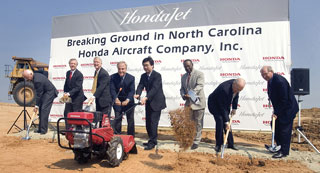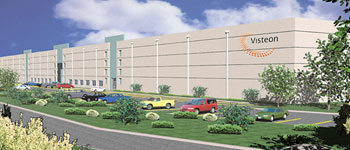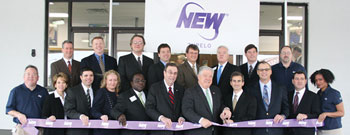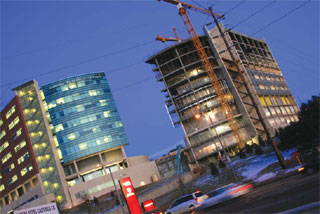![]()
![]()


he bright lights of the big cities may grab the attention of the major media, but when it comes to economic development, no one does it better than Middle America.
From the rolling hills of Scranton, Pa., to the riverboats of St. Louis, the iconic images of America’s Heartland form the backdrop of the top-performing economic development organizations in the country. Their hometowns read like a Who’s Who of Main Street America: Scranton, Tupelo, Lexington-Thomasville, Cincinnati, Pittsburgh, Akron, Chicago, Sioux City, St. Louis and Greensboro.
Those 10 communities are the anchor cities of this year’s Top Economic Development Groups. Every year, Site Selection selects the winning organizations based upon the following criteria: total capital investment; investment per capita; total jobs created; jobs created per capita; the contributions of the local or regional economic development organization toward the attainment of these numbers; overall economic vitality; depth and breadth of economic strength; diversity of industry; ability to generate breakthrough deals; and the ability to provide verifiable documentation for all projects.
The Conway Data New Plant Data- base supplies the data used by the editors to determine the winners. For a project to be counted, it must be corporate owned and occupied and represent at least $1 million of capital investment, the creation of at least 50 jobs or the addition of at least 20,000 sq. ft. (1,858 sq. m.).
The database tracks corporate and industrial space including headquarters, manufacturing plants, distribution warehouses, service centers, call centers and other related facilities. Hospitals, schools, restaurants, retail stores, churches, government buildings and other institutional projects are omitted.
Based upon the above criteria, the organizations doing the best job of economic development can be found in places that many overlook: the so-called Rust Belt and Deep South. But one thing is certain – corporate executives are not overlooking them.
Consider the stories of these winning groups for 2007, listed in alphabetical order by city, county or region:
Akron, known to many as The Rubber Capital of the World, made headlines in 2007 thanks to a record-breaking investment from a tire company. What many executives may not know, however, is that Akron is also developing a reputation as a hotbed of high-tech innovation.
“There are 27 universities and colleges within 50 minutes of Akron,” says Richard Rebadow, senior vice president of economic development for the Greater Akron Chamber. “Only one other location in the U.S. has that – New York. The University of Akron and Kent State are facilitating talented graduates. We are in the midst of a transformation to a knowledge-based economy.”
On the way there, a number of mainstay companies keep deepening their roots in the community. Goodyear Tire & Rubber Co. topped all investors with an $890-million headquarters project that will add 450,000 sq. ft. (41,805 sq. m.) in Akron. At press time, local and state government officials had pledged $68 million to entice Bridgestone Firestone to retain 629 jobs in the city.
In 2007, Greater Akron landed 29 corporate expansion projects, second only to Greensboro-High Point, N.C., in the population category of 200,000 to 1 million. Total investment in the Akron area reached $1.052 billion last year, with 1,203 jobs added to the local economy.
Many of these jobs are being created in the advanced materials cluster, an offshoot of the rubber industry. As a result, Akron has earned a new nickname: the “Polymer Center of the Americas.”

Chicago is known for having some of the world’s best baseball fans, thanks to the incredibly loyal followings of both the Cubs and the White Sox. But the Windy City has quickly built a reputation for something else: When it comes to economic development, there’s not another large city in America that does it better.
For three years in a row and six of the last seven, metro Chicago has ranked No. 1 in America in corporate project activity. In 2007, the Windy City dominated the competition by registering 236 facility deals. World Business Chicago was the common denominator for most of them.
From Abbott Labs‘ planned $1.2-billion pharmaceuticals complex in Pleasant Prairie, Wis., to Microsoft‘s $500-million data center in Northlake, Ill., the Second City MSA finished second to no one last year, tallying 32,767 new jobs and more than $2 billion in capital investment.
“Mayor Richard Daley’s strategy for Chicago has been to attract 24-to-35-year-old professionals, and that has been a real boon for us,” says Rita Athas, executive director of WBC. “There is a real quality of life here that is very affordable, with access to world-class institutions.”
Many of those young professionals are being hired at places like CareerBuilder.com, which announced a 500-employee expansion in 2007. WBC worked with the company last year to retain the corporate headquarters and some 1,415 jobs in Chicago. The firm now occupies 220,000 sq. ft. (20,438 sq. m.) in four locations around the city.
Thirty years ago, a dynasty known as The Big Red Machine captured the fascination of baseball fans everywhere. In 2007, another lineup emerged on the landscape of economic development and was every bit as potent as the juggernaut of Pete Rose, Johnny Bench, Joe Morgan and manager Sparky Anderson.
It’s called Cincinnati USA, a tri-state regional partnership that elevated the regional area to the second-best performing metro in the nation. With 111 corporate facility projects last year, the Cincinnati-Middletown MSA ranked No. 2 behind Chicago.
For the year, Cincinnati USA attracted $2.71 billion in capital investment and created or retained 20,931 jobs. The total economic impact of the year’s haul was $5.7 billion.
“We had several signature projects,” says Neil Hensley, senior director of economic development for Cincinnati USA. “One was Tata Consultancy Services, which established its North American headquarters in this region and brought 1,000 jobs. This is our largest project in the past 10 years.”
The region’s biggest capital investment came from Amylin Pharmaceuticals, which announced a $400-million manufacturing project in West Chester, Ohio. The facility deal adds 500 jobs and 240,000 sq. ft. (22,296 sq. m.). Other big deals came from Ford Motor Co. ($200 million in Sharonville, Ohio) and General Motors Corp. ($102 million in Monroe, Ohio).
“Changes in Ohio’s tax structure have had a very positive impact on manufacturers considering Ohio,” says Hensley. “One company was looking at us as a location for an aerospace manufacturing facility. Due to the tax law changes, Cincinnati went from being the most expensive to the least expensive on the list of cities they were considering.”
Beating an entrenched incumbent at its own game is no easy task. Just ask Steve Googe, the executive director of the Davidson County Economic Development Commission. In 2007, the work performed by his group helped propel tiny Lexington-Thomasville, N.C., past Statesville-Mooresville, N.C., for the Top Micropolitan Area of the Year in total corporate projects.
It wasn’t an accident. From 2000 through 2006, the county lost 7,500 jobs as old textile mills and furniture factories went out of business or moved offshore. But out of loss came opportunity, notes Googe, as the area went to work marketing some 10 million sq. ft. (929,000 sq. m.) of vacant industrial space.
The results came dramatically in 2007. The county landed a record 30 new plants or expansions totaling $160 million in investment and creating 3,459 jobs. The largest came from Unilin Flooring, which announced a $30-million factory expansion in Thomasville.
The area benefits from the success of Richard Childress Racing, a motorsports operation that emerged this year as the most dominant race team in NASCAR. In late 2007, RCR announced two expansion projects totaling $9 million, 70 jobs and 118,000 sq. ft. (10,962 sq. m.).
“Racing technology companies represent a growing industry in the county,” Googe says. “A lot of the technology that is brought to Davidson County generates more of that type of business coming here.”
From Winston-Salem to Greensboro-High Point, the Piedmont Triad region has established itself as the most competitive location in the most competitive state in America.
The numbers say it all. For the past decade, North Carolina has consistently ranked as the No. 1 business climate in the nation, according to the annual survey conducted by Site Selection,

and one of the top five states for new and expanded industrial plants.
Within the Tar Heel state, no region has fared better than the Piedmont Triad. With 30 corporate facility projects in Greensboro-High Point and another 10 in Winston-Salem last year, the region recorded some impressive numbers, totaling $406 million in investment and 2,041 jobs.
Don Kirkman, president and CEO of the Piedmont Triad Partnership, was quick to give credit to the group’s regional and state partners. “North Carolina has embraced a statewide strategy that leverages the strength of its very diverse landscape,” he says. “North Carolina has been a pioneer in regional economic development.”
The region’s largest deal last year came from KobeWieland Copper Products, which announced a $71-million investment in a copper pipe factory expansion in Pine Hall, N.C. The area’s biggest job generator came from C.P. Morgan, which announced a 400-job headquarters project in Forsyth County.
Greensboro’s largest investment came from Honda Aircraft Co., which announced a $60-million facility deal in early 2007. High Point’s signature project was announced by TransTech Pharma – a $23-million deal that creates 205 jobs.
Site selectors who still think of Pittsburgh as the Steel City may want to pay a visit to this metro area in Western Pennsylvania. It’s come a long way since the days of Terry Bradshaw and Mean Joe Greene.
Yes, the Steelers of the NFL are as popular as ever, but industry-wise, the city made famous by the convergence of three rivers has a lot more to offer these days than iron, aluminum and other metals.
That’s because longstanding corporate citizens like U.S. Steel and Alcoa have become world leaders in advanced materials research and, in turn, attracted a bevy of like-minded companies to join them.
In 2007, the metro area landed 36 corporate facility projects that totaled $2.8 billion in capital investment and created 1,702 jobs. The largest was U.S. Steel‘s $1-billion manufacturing expansion in Clairton. Other big deals came from Consus Ethanol in Aliquippa ($750 million) and ST Paper LLC in Uniontown ($600 million).
The largest job generators came from Westinghouse Electric, which is adding 1,000 jobs in Cranberry Township; Lanxess Corp., which expanded by 360 jobs in Pittsburgh; and Verizon Wireless, which added 338 positions in Warrendale.
Mike Langley, CEO of the Allegheny Conference on Community Development (which counts the Pittsburgh Regional Alliance as an affiliate), says the region has been undergoing a steady transformation. “Certainly, the steel industry and the other large industries of Pittsburgh have changed dramatically, but they have not disappeared,” he says. “They have become very high-tech and have led a resurgence of the advanced materials industry in our region. U.S. Steel is headquartered here and has more than 1,000 researchers doing advanced research in metallurgy and steel. The same thing is happening at Alcoa, Eaton Electric, PPG, Westinghouse and other companies based here.”
The River City welcomes visitors who want to pass through the famed Arch on the Mississippi and catch a glimpse of America’s expansionist past. But the people and businesses of St. Louis are equally focused on the city’s growth-marked future.
That focus is spearheaded by the St. Louis Regional Chamber & Growth Association, which in 2007

put up eye-popping numbers in corporate projects, jobs and capital investment. With 95 facility deals, St. Louis ranked third in the nation. The projects totaled $1.517 billion in investment and accounted for 3,555 new jobs throughout the bi-state region.
Topping the project list were Abengoa Bioenergy‘s $200-million ethanol plant in Madison, Ill., and VeraSun Energy‘s $150-million ethanol plant in Granite City, Ill. The biggest employment impacts came from Monsanto Corp., which announced 224 new jobs in Chesterfield, Mo., and American Family Insurance, which created 221 positions at a call center in Creve Coeur, Mo.
“Since we rolled out a $21-million economic development campaign in 2005 and launched a branding effort in the first quarter of 2006, we’ve seen our deal flow triple,” says Dick Fleming, president and CEO of the St. Louis Regional Chamber & Growth Association. “The only disappointment is to be behind Chicago in anything. We will strive to overtake Chicago.”
If the first quarter of 2008 is any indication, Fleming may be on his way to getting his wish. Through the first three months of the year, the RCGA had made the short list on 90 facility projects. “Those represent 14,000 jobs and over $3 billion in potential new capital investment,” says Fleming.
The fictional Dunder Mifflin Paper Co. may have put Scranton on the map of pop culture thanks to the hit NBC comedy The Office, but there’s nothing fictitious about the corporate project activity occurring in Lackawanna County these days.
Thanks to the foresight of The Scranton Plan – the economic development arm of the Greater Scranton Chamber of Commerce – industry is flocking to Scranton these days faster than Steve Carell’s Michael Scott character can call yet another meeting.
In 2007, the Scranton-Wilkes Barre metro area generated 14 corporate projects that added $446 million in capital investment and created 1,943 jobs. About 5 million sq. ft. (464,500 sq. m.) was announced as part of these deals.
More than half of that total came from two projects. Lowe’s announced a 1.4-million-sq-ft. (130,060-sq.-m.) warehouse in Pittston, while Circuit City Stores announced a 1.27-million-sq.-ft. (117,983-sq.-m.) distribution center in Covington Township. Together, the investments total $149 million and add 700 jobs.
“Decades of preparation went into the success we experienced in 2007,” says Austin Burke, president of the Greater Scranton Chamber. “Investments like these do not happen overnight. Three dates were very important. We formed the Scranton Lackawanna Industrial Building Company (SLIBCO) in 1913. The first Scranton Plan for economic development was put together in 1946. And then we did a new Scranton Plan in 1981 to form a marketing organization that would reach out to businesses.”
The Scranton Plan, which has been recognized nationally for its effectiveness in marketing, has helped the community land a number of tenants for the facilities built by SLIBCO. Last year, SLIBCO secured 1,471 new jobs and $155 million in capital investment in Lackawanna County.
The breakthrough deal came from McLane Co., the nation’s leading wholesale distributor of food and consumer packaged goods. McLane is moving into 420,000 sq. ft. (39,018 sq. m.) on 59 acres (24 hectares) in the Valley View Business Park in Jessup and creating 500 jobs.
The corners of three states come together along the Missouri River in northwestern Iowa to form the community known as Sioux City. Leaders in Nebraska, South Dakota and Iowa want Sioux City to become even more renowned for the way it brings people and prosperity together.
The Siouxland Initiative, the economic development program of the Siouxland Chamber, is the signature coalition of that effort. A partnership that spans three states, four counties and five cities, the Initiative delivered a record haul of facility projects in 2007, as well as the jobs and capital investment to match.
With 23 deals in 2007, Sioux City led all metro areas with population under 200,000. Those projects accounted for $188 million in capital investment and 1,155 new jobs.
Prime BioSolutions led all deals with $85 million in capital investment in Dakota City, Neb. Alorica led the way in employment by announcing two call center expansions creating 600 jobs in North Sioux City, S.D.
“The uniqueness of having the tri-state area here is a huge business advantage,” says Debi Durham, president of both the Siouxland Initiative and its parent organization, the Siouxland Chamber of Commerce. “Each state has its own available land, buildings and incentives. The variety that we can offer companies with one commercial center is unmatched.”
The Siouxland Initiative targets food processing, biotech, advanced manufacturing, insurance and financial services, call centers and information-technology companies – and its performance in 2007 showed growth in all of those sectors.
Toyota‘s legendary reputation for quality tends to follow the company everywhere it goes. Lee County, Miss., is no exception.
When the Japanese automaker and global leader announced in February 2007

that it would build a huge assembly plant near Tupelo, it only confirmed what many corporate executives already knew about the area: Lee County supports business.
The Community Development Foundation, led by president and CEO David Rumbarger, serves on the front lines of that effort. The CDF played a lead role in helping Mississippi secure the $1.3-billion Toyota Motor Manufacturing plant in Blue Springs – a project that will create up to 2,000 jobs and more 500,000 sq. ft. (46,450 sq. m.) on 1,700 acres (689 hectares). Crucial to the attraction of Toyota was Lee County’s alliance with Pontotoc and Union counties to form the PUL Alliance.
“We started eight years ago on a real quest to diversify our economy,” says Rumbarger. “Toyota was the culmination of a lot of converging forces. Given Toyota’s worldwide reputation for quality, we are very proud of landing this company. This is a great stamp of approval for our area.”
It wasn’t the only one either. Toyota Auto Body Co. announced in September that it would build its first U.S. plant in Baldwyn. The $200-million plant is slated to open in 2010 and employ 400 workers.
NEW Customer Service Companies announced that it will invest $3.6 million into a new call center in Lee County, adding 350 jobs and 36,000 sq. ft. (3,344 sq. m.), while Cooper Tire and Rubber Co. will invest $7 million in an expansion in Tupelo.
When Research in Motion Ltd. announced in December that it had selected Irving, Texas, for its U.S. headquarters, the decision was but the latest in a string of big deals landing in the Dallas-Fort Worth-Arlington metro area in 2007.
With 73 corporate facility projects last year, DFW ranked as the sixth-leading metro in the country. With 8,623 jobs created by those projects, the metro area ranked second only to Chicago.
RIM, maker of the ubiquitous BlackBerry mobile email device, is bringing 1,000 jobs to a 100,000-sq.-ft. (9,290-sq.-m.) office complex in DFW. Two other projects are also generating 1,000 jobs each: Maxim Integrated Products in Irving and Blue Cross and Blue Shield of Texas in Richardson.
The 73 projects announced in the metro area last year totaled $879 million in capital investment. The DFW area also ranked as the fastest growing MSA in population in the nation in 2007, according to the U.S. Census Bureau.
Dyer County may be small, with just 38,000 inhabitants, but the community in Northwest Tennessee packs a lot of punch. In 2007, the county landed five significant corporate real estate deals, totaling $56 million in capital investment and generating more than 840 new jobs.
The biggest deal came from Briggs & Stratton, which announced that it will invest $21 million in a 600-job factory for small engines in Newbern. Dyersburg, meanwhile, is getting a $14-million expansion of a printing plant by Quebecor World.
NSK Steering Systems America Inc. purchased a 100,000-sq.-ft. (9,290-sq.-m.) spec building from the county and will locate its automotive steering assembly operation there.
Tonya Traylor, vice president of research for the Dyersburg/Dyer County Chamber of Commerce, says that the top county assets include “a dependable work force, progressive schools, affordable living, low crime rate, exciting growth and small-town friendliness.”
The Houston-Baytown-Sugar Land metro area ranked fourth in the nation in 2007 with 75 corporate facility deals totaling $539 million in capital investment.
The Greater Houston Partnership serves a 10-county region that has a population of 5.54 million people. Opportunity Houston, the partnership’s 10-year strategic plan, has set as a goal raising $40 million, the purpose of which is to drive economic development that attracts $60 billion in capital investment and creates 600,000 net regional jobs.
Large deals in 2007 came from ExxonMobil, which announced a $600-million liquefied natural gas terminal, and Freeport LNG Development, which also announced a $600-million LNG terminal. Both are located on Quintana Island in Brazoria County.
“The high location quotient for engineering disciplines and the pool of highly educated workers help the Houston region attract corporate headquarters, professional service providers and other major employers,” says Miguel San Juan, senior vice president of business development for the GHP.
The capital of Michigan recorded a banner year in 2007, thanks to several large corporate real estate deals. With nine facility projects totaling $269 million in capital investment, the city of Lansing and surrounding Ingham County led an economic development resurgence in Central Michigan.
The nine projects created 1,259 new jobs throughout the county, with 500 of them coming from Accident Fund Insurance Company. AFI announced a $130-million project in Lansing that will result in 280,000 sq. ft. (26,012 sq. m.) of new space.
Other big deals were announced by Delta Dental of Michigan ($85 million in Okemos) and Peckham Manufacturing ($18 million and 300 jobs in Lansing).
“Ingham County is partnering with a new regional organization, the Lansing Economic Area Partnership (LEAP) to expand our Web presence and promote developable sites in the area,” says Susan Pigg, president of the Ingham County Economic Development Corp. “We are working with LEAP to coordinate and improve the response times and quality of information available to corporate prospects considering our region.”
Call it a breakthrough year for McHenry County, Ill. With 17 corporate facility projects representing $92 million in capital investment and 1,702 new jobs, the Northern Illinois county between Chicago and the Wisconsin border delivered a superior economic development performance.
Leading the way was Chemtool, which announced a $30-million, 150-job manufacturing expansion in Marengo. Affinia-Under Vehicle Group Inc. announced a $17-million expansion of its hydraulics distribution warehouse in the town of McHenry, adding 217,000 sq. ft. (20,159 sq. m.).
“We are seeing expansions caused by the relocation of production from overseas back to our McHenry County plants,” says Chris Manheim, president of the McHenry County Economic Development Corp. “One example is the relocation of specialized aerospace/defense magnetic production by Arnold Magnetic Technologies.”
Arnold created 82 jobs with the expansion project in Marengo. The company makes magnetic rolled products.
The tri-state region of Memphis, encompassing portions of Tennessee, Arkansas and Mississippi, lived up to its reputation as a logistics hub for the world in 2007 – but it also added major real estate developments in other sectors.
The biggest investment came from Nike, which announced a $107-million distribution warehouse in Shelby County, Tenn. The 1-million-sq.-ft. (92,900-sq.-m.) project will create 594 jobs. The next largest facility deal came from GlaxoSmithKline, which announced a $70-million pharmaceutical factory expansion in Shelby County.
For the year, the Memphis metro area recorded 55 facility projects totaling $590 million and generating 3,234 jobs. The largest jobs creator was Technicolor Videocassette Inc., which expanded its distribution center in Memphis by 830 workers.
The Memphis Regional Chamber assists site selectors by providing a comprehensive website – MemphisDelivers.com – that includes key data points needed by corporate real estate executives when conducting a search for a facility location.
Financial guru Warren Buffett makes his home in Omaha, Neb., but so do a lot of other corporate executives. Berkshire Hathaway, No. 12 on the Fortune 500 list, is joined by the headquarters of Union Pacific Corp. (No. 151),

ConAgra Foods Inc. (No. 173), Peter Kiewit Sons Inc. (No. 446) and Mutual of Omaha Companies (No. 489).
In 2007, these firms were joined by many other expanding companies. Among them was Google, which announced a $600-million, 200-job data center project in Council Bluffs, Iowa, which is part of the Greater Omaha metro area. In nearby Glenwood, Iowa, Council Bluffs Ethanol announced a $214-million, 45-job ethanol plant.
For the year, Greater Omaha attracted 29 facility expansion projects representing more than $1 billion in capital investment and the creation of 1,362 jobs. The biggest employment impact came from Medical Solutions Inc., which announced a bioscience manufacturing expansion creating 221 jobs in Omaha.
“More than $2 billion worth of new capital investment have come to downtown Omaha and the riverfront in the last seven years,” says Rod Moseman, vice president of economic development for the Greater Omaha Economic Development Partnership. “Several new corporate headquarters buildings have changed our skyline, including Gallup and Union Pacific.”
The Plattsburgh-North Country region of Upstate New York may be small, with about 200,000 people in four counties, but it’s no stranger to major companies from both the United States and Canada.
Often called “Montreal’s U.S. Suburb,” the region serves as the hub of the Quebec-New York Corridor and the gateway to New York’s Tech Valley. Located in the heart of the Adirondacks, the area also offers an attractive quality of life.
In 2007, the region landed six projects totaling $142 million in capital investment and creating more than 800 jobs. The signature deal came from Laurentian Aerospace, which announced a $135-million, 750-jobs headquarters project in Plattsburgh in Clinton County. The area also reaped investments from companies in the printing, robotics and sports equipment sectors.
Two big public works projects were the Port of Excellence at the Champlain border crossing, a $107-million project that opened in February 2007, and the opening of a new passenger terminal in June 2007 at Plattsburgh International Airport.
The future of Saginaw is now, as Hemlock Semiconductor embarks on $1.146 billion in polycrystalline silicon manufacturing expansion projects in Hemlock, Mich., in Saginaw County.
Eight facility deals creating more than 500 new jobs were announced in the county last year, which is significant for an area of just 200,000 residents. And if Saginaw Future has its way, more jobs will be on the way soon.
“Saginaw Future Inc., Midland Tomorrow and Bay Future Inc. are cooperating to develop and launch a Photovoltaic Initiative. The ultimate goal is to attract new companies and build the solar industry in the region,” says Greg LaMarr, marketing coordinator for Saginaw Future. “The three economic development organizations are developing a specific attraction plan that identifies and targets solar-related industries. These efforts include strength analysis, site identification and the creation of collateral materials.”
Forbes magazine recently rated Saginaw as the No. 6 Metro Area for Cost of Living. Money magazine named Saginaw the No. 1 Up and Coming Area for its population size.
Most communities, when faced with the loss of their largest employer, would find the road to recovery both long and taxing. Ohio’s Wayne County does things a little differently.
Just four years after losing Rubbermaid and its 1,400 jobs, the micropolitan area anchored by Wooster wrapped up its second consecutive year in 2007 as the highest performing micro in the Midwest in terms of corporate facility development.
With 17 projects last year totaling $66 million in capital investment and creating 743 jobs, Wayne County achieved benchmarks that outpace most larger communities. In fact, Wooster has ranked second and third, respectively, in facility projects in the country in the last two years.
From J.M. Smucker’s $15-million food-products facility to Stonecraft‘s $13-million cultured-stone factory expansion, Wayne County showed considerable diversity in its economic development activity in 2007. Nearly 1 million sq. ft. (92,900 sq. m.) of new space was added last year as part of these deals.
More importantly, notes Rod Crider, president of the Wayne Economic Development Council, the average income of the jobs associated with the WEDC’s efforts is 75 percent higher than the current county average and 52 percent higher than the current Ohio average.
“The most important metric is whether per capita income is increasing,” Crider says. “If wealth is increasing, then economic development is occurring.”
Site Selection Online – The magazine of Corporate Real Estate Strategy and Area Economic Development.
©2008 Conway Data, Inc. All rights reserved. SiteNet data is from many sources and not warranted to be accurate or current.